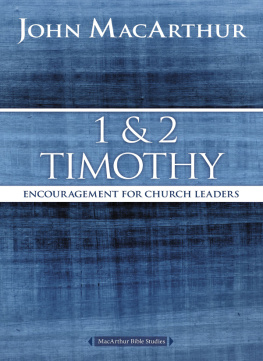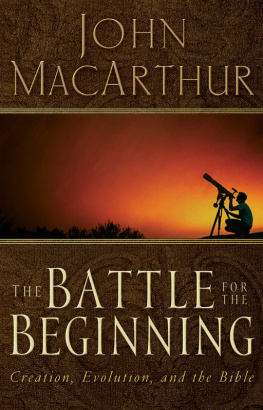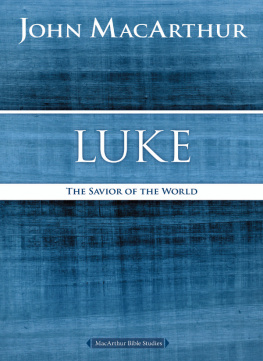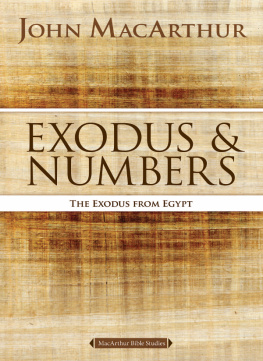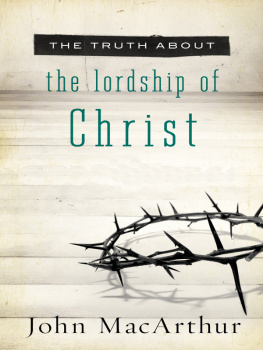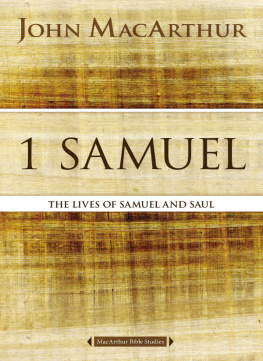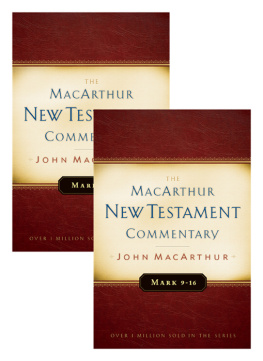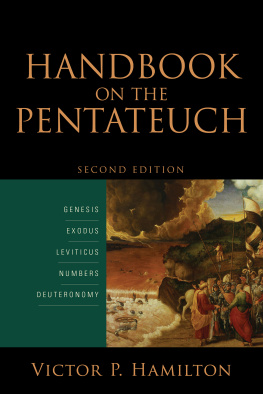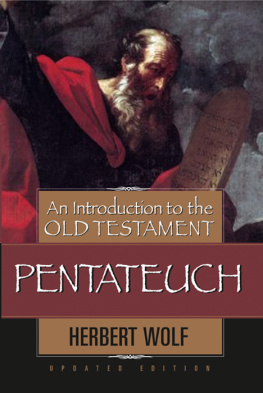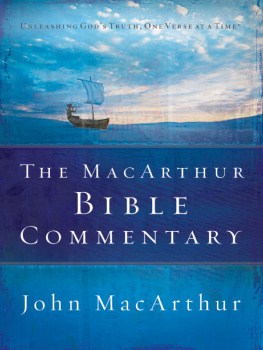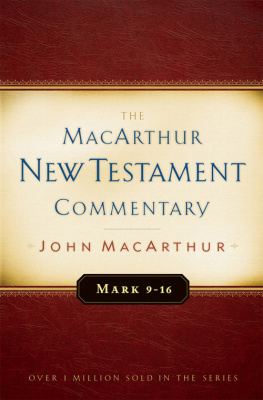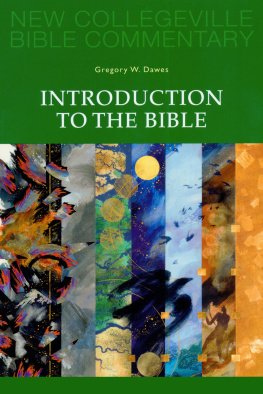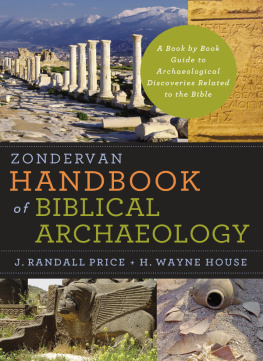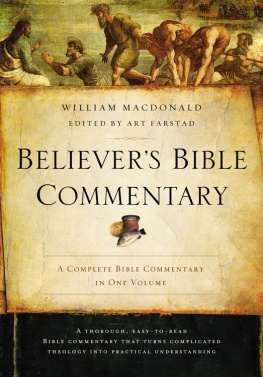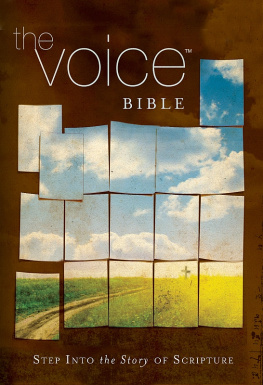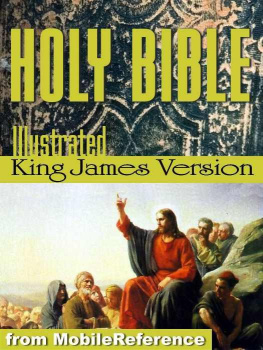
1 & 2 TIMOTHY
MACARTHUR BIBLE STUDIES
2007 John F. MacArthur, Jr.
All rights reserved. No portion of this book may be reproduced, stored in a retrieval system, or transmitted in any form or by any meanselectronic, mechanical, photocopy, recording, or any otherexcept for brief quotations in printed reviews, without the prior permission of the publisher.
Published in Nashville, Tennessee, by Nelson Books, an imprint of Thomas Nelson. Nelson Books and Thomas Nelson are registered trademarks of HarperCollins Christian Publishing, Inc.
Nelson Books titles may be purchased in bulk for education, business, fundraising, or sales promotional use. For information, please email SpecialMarkets@ThomasNelson.com.
Published in association with the literary agency of Wolgemuth & Associates, Inc.
Produced with the assistance of the Livingstone Corporation. Project staff include Jake Barton, Betsy Todt Schmitt, and Andy Culbertson. Project editors: Mary Horner Collins, Amber Rae, and Len Woods.
Scripture quotations marked NKJV are taken from the The New King James Version. Copyright 1982 by Thomas Nelson, Inc. Used by permission. All rights reserved.
Unleashing Gods Truth, One Verse at a Time is a trademark of Grace to You. All rights reserved.
Keys to the Text material taken from the following sources:
1 Corinthians. MacArthur New Testament Commentary Series. Copyright 1984, 1996 by John MacArthur. Published by Moody Press, Chicago, Illinois. Used by permission.
The MacArthur Study Bible (electronic ed.). John MacArthur, General Editor. Copyright 1997 by Word Publishing. All rights reserved. Used by permission.
Nelsons New Illustrated Bible Dictionary, Rev. ed. R. F. Youngblood, F. F. Bruce, R. K. Harrison, editors. Copyright 1995 by Thomas Nelson Publishers. Used by permission.
Our Sufficiency in Christ (electronic ed.) Copyright 1997 by John F. MacArthur. Published by Word Publishing: Dallas, Texas. Use by permission.
Cover Art by Holly Sharp Design
Interior Design and Composition by Joel Bartlett, Livingstone Corporation
ISBN-13: 978-0-7180-3514-3
ISBN-13: 978-0-7180-3533-4 (eBook)
In this ebook edition, please use your devices note-taking function to record your thoughts wherever you see the bracketed instructions [Your Notes] or [Your Response Here]. Use your devices highlighting function to record your response whenever you are asked to checkmark, circle, underline, or otherwise indicate your answer(s).
CONTENTS
This is the first of two inspired letters Paul wrote to his beloved son in the faith. Timothy received his name, which means one who honors God, from his mother (Eunice) and grandmother (Lois), devout Jews who became believers in the Lord Jesus Christ (2 Tim. 1:5). They taught Timothy the Old Testament Scriptures from his childhood (2 Tim. 3:15). His father was a Greek (Acts 16:1) who may have died before Timothy met Paul.
Timothy was from Lystra (Acts 16:13), a city in the Roman province of Galatia (part of modern Turkey). Paul led Timothy to Christ (1:2, 18; 1 Cor. 4:17; 2 Tim. 1:2), undoubtedly during his ministry in Lystra on his first missionary journey (Acts 14:623). When he revisited Lystra on his second missionary journey, Paul chose Timothy to accompany him (Acts 16:13). Although Timothy was very young (probably in his late teens or early twenties, since about fifteen years later Paul referred to him as a young man, 4:12), he had a reputation for godliness (Acts 16:2). Timothy was to be Pauls disciple, friend, and co-laborer for the rest of the apostles life, ministering with him in Berea (Acts 17:14), Athens (Acts 17:15), and Corinth (Acts 18:5; 2 Cor. 1:19), and accompanying him on his trip to Jerusalem (Acts 20:4). He was with Paul in his first Roman imprisonment and went to Philippi (2:1923) after Pauls release. In addition, Paul frequently mentions Timothy in his epistles (Rom. 16:21; 2 Cor. 1:1; Phil. 1:1; Col. 1:1; 1 Thess. 1:1; 2 Thess. 1:1; Philem. 1). Paul often sent Timothy to churches as his representative (1 Cor. 4:17; 16:10; Phil. 2:19; 1 Thess. 3:2), and 1 Timothy finds him on another assignment, serving as pastor of the church at Ephesus (1:3). According to Hebrews 13:23, Timothy was imprisoned somewhere and released.
AUTHOR AND DATE
Many modernist critics delight in attacking the plain statements of Scripture and, for no good reason, deny that Paul wrote the Pastoral Epistles (1, 2 Tim., Titus). Ignoring the testimony of the letters themselves (1:1; 2 Tim. 1:1; Titus 1:1) and that of the early church (which is as strong for the Pastoral Epistles as for any of Pauls epistles, except Romans and 1 Corinthians), these critics maintain that a devout follower of Paul wrote the Pastoral Epistles in the second century. As proof, they offer five lines of supposed evidence: (1) the historical references in the Pastoral Epistles cannot be harmonized with the chronology of Pauls life given in Acts; (2) the false teaching described in the Pastoral Epistles is the fully developed Gnosticism of the second century; (3) the church organizational structure in the Pastoral Epistles is that of the second century and is too well developed for Pauls day; (4) the Pastoral Epistles do not contain the great themes of Pauls theology; and (5) the Greek vocabulary of the Pastoral Epistles contains many words not found in Pauls other letters, nor in the rest of the New Testament.
While it is unnecessary to dignify such unwarranted attacks by unbelievers with an answer, occasionally such an answer does enlighten. Thus, in reply to the critics arguments, the following points are given: (1) This contention of historical incompatibility is valid only if Paul was never released from his Roman imprisonment mentioned in Acts. But he was released, since Acts does not record Pauls execution, and Paul himself expected to be released (Phil. 1:19, 2526; 2:24; Philem. 22). The historical events in the Pastoral Epistles do not fit into the chronology of Acts because they happened after the close of the Acts narrative, which ends with Pauls first imprisonment in Rome. (2) While there are similarities between the heresy of the Pastoral Epistles and second-century Gnosticism, there are also important differences. Unlike second-century Gnosticism, the false teachers of the Pastoral Epistles were still within the church (see 1:37), and their teaching was based on Judaistic legalism (1:7; Titus 1:10, 14; 3:9). (3) The church organizational structure mentioned in the Pastoral Epistles is, in fact, consistent with that established by Paul (Acts 14:23; Phil. 1:1). (4) The Pastoral Epistles do mention the central themes of Pauls theology, including the inspiration of Scripture (2 Tim. 3:1517); election (2 Tim. 1:9; Titus 1:12); salvation (Titus 3:57); the deity of Christ (Titus 2:13); His mediatory work (1 Tim. 2:5); and substitutionary atonement (2:6). (5) The different subject matter in the Pastoral Epistles required a different vocabulary from that in Pauls other epistles. Certainly a pastor today would use a different vocabulary in a personal letter to a fellow pastor than he would in a work of systematic theology.
The idea that a pious forger wrote the Pastoral Epistles faces several further difficulties: (1) The early church did not approve of such practices and surely would have exposed this as a ruse, if there had actually been one (see 2 Thess. 2:12; 3:17). (2) Why forge three letters that include similar material and no deviant doctrine? (3) If a counterfeit, why not invent an itinerary for Paul that would have harmonized with Acts? (4) Would a later, devoted follower of Paul have put the words of 1 Timothy 1:13, 15 into his masters mouth? (5) Why would he include warnings against deceivers (2 Tim. 3:13; Titus 1:10), if he himself were one?
Next page
